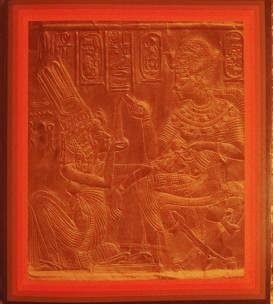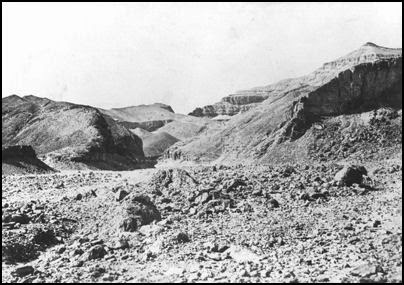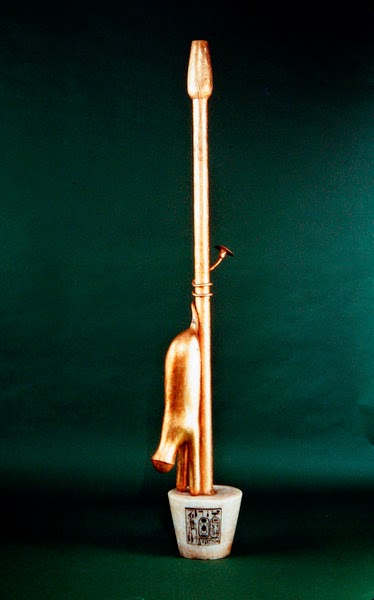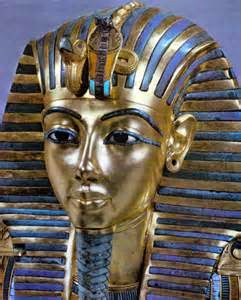Egypt

British Museum Exhibition
The Trustees of the British Museum
Thames & Hudson Ltd
London
1972
ISBN 0 7230 0070 0
Here we have the guide to The British Museum's highly successful 1972 Treasures of Tutankhamun exhibition brought together to celebrate the 50th anniversary of the discovery of Tutankhamun's tomb in Egypt's famous royal cemetery the Valley of Kings. The funds raised from the show went to the preservation of the temples of Philae.
The guide written by I.E.S. Edwards then Keeper of Egyptian Antiquities at the British Museum has some wonderful details of life in the middle of the 14th century BC under the luxuriant King Amenophis III to Amenophis IV's elevation of the solar disk of the Aten above and in place of all the other gods excepting Re who was the old seat of the Aten. The revolution created havoc within Egypt and her empire so that by the reign of Tutankhamun the empire was a mess leaving the nine year old king with his advisers including his vizier Ay and general Horemheb to restore the damage to the old temples, priesthoods and the empire.
By year 3 of Tutankamun's reign he has left the heretic capital of the Aten and returned to Thebes to take up residence in his grandfathers former palace at Malquata as well as at the historic capital of Memphis. Tutankhamun spends his reign making repairs to the monuments while restoring the offerings to the temples including to Amun at Karnak where he leaves a great stela marking his deeds.
The author brings to life some of the monuments of the boy kings time including two granite lions in the British museums collection.
"It is one of a pair of pink granite lions which Amenophis III intended to place in his newly-built temple at Sulb in Nubia, but the work on the second lion was only in its early stages when he died. Tutankhamun finished the work and put an inscription to that effect on the pedestal. It must have been one of his last undertakings, because an inscription on the breast of the lion records it was taken to Sulb by his successor Ay."
Little more is known of him except that he was laid to rest in a nobles tomb as presumably his own was not ready by the untimely death of the king. Within two centuries of his burial the tomb would be robbed twice and eventually buried under the refuse from the carving of the tomb of Ramses VI nearby and then further buried under flood debris.

The author is next on to the discovery by Howard Carter and Lord Carnarvon including the various excavations which turned up clues to Tutankhamun's burial being in the valley. These discoveries included a faience cup bearing the kings name, some foils turned up in tomb KV56 bearing his and Ankhesanamun's images and a pit in the valley numbered KV54 which contained items from the tomb and the remains of a funerary meal had in the kings honor.
The next section contains beautiful coloured images of various objects in the show including the kings famous gold mask which by Egyptian law is no longer allowed to leave Egypt. There have been many exhibitions on Tutakhamun's treasures over the years this was not the first though in this 50th anniversary show are exhibits that I cannot find being part of any of the other exhibitions that have traveled over the years.
The Catalogue
 Nowhere in the world outside Cairo would the life size sentinel statue of Tutuankhamun be so poignant as the British Museum which posses three such figures collected in the kings valley early in the nineteenth century by Giovoni Belzoni, who found two of the figures in the tomb of the XIX Dynasty King Ramses I. Unlike most of the pieces in this catalogue this figure does not appear to have traveled to be part of the North American tour of the exhibition.
Nowhere in the world outside Cairo would the life size sentinel statue of Tutuankhamun be so poignant as the British Museum which posses three such figures collected in the kings valley early in the nineteenth century by Giovoni Belzoni, who found two of the figures in the tomb of the XIX Dynasty King Ramses I. Unlike most of the pieces in this catalogue this figure does not appear to have traveled to be part of the North American tour of the exhibition.
The large alabaster leomorphic unguent vase displays a crowned lion on his hind legs waving with his tongue stuck out and a favorite piece for me. Among the objects in the show must be some of the most traveled artifacts in history included the kings crook and flail of which the tomb contained repetitive examples. A canopic jar lid in the guide has an interesting black and white picture showing the underside of the stopper.
No Tutakhamun exhibition would be complete without one of the coffinettes that held the young kings viscera. The tomb contained a number of funerary gifts from Tutankhamun's officials including the small carved effigy given by the boy kings treasurer Maya.
Inscriptions on the gilded bed of the divine cow show that the beds are funerary in nature, but because they are unique in the round much is still not entirely understood about them and their use. A number of pieces of furniture pass including a small chair about the same size as another chair found in the Valley of Kings in tomb Kv46 made for a relative of Tutankhamun's, Princess Sitamun though the kings chair is not quite a elaborate as the princess'.
 A beautiful gold figure of the king appears on a small staff where his appearance is that of a boy, while an ostrich fan presents the king as a hunter of the large birds. The show contained one of the two gilded wood emblems of Anubis mounted on alabaster stands found in the two western corners of the burial chamber.
A beautiful gold figure of the king appears on a small staff where his appearance is that of a boy, while an ostrich fan presents the king as a hunter of the large birds. The show contained one of the two gilded wood emblems of Anubis mounted on alabaster stands found in the two western corners of the burial chamber.
"An early example, found in 1914 by the Metropolitan Museum of Art near the pyramid of Sesostris I (1971-1928 BC) at El Lischt, was placed in a wooden shrine. Like the emblem in Tutankhamun's tomb, it consisted of a wooden rod and an alabaster stand, but the headless animal skin was real and it was stuffed with linen.","The stand, which resembled a vessel, was about two-thirds full of a bluish-coloured substance, completely dried and considered to be some kind of ointment."
Truly one of the great pieces in the collection must be the shrine covered in sheet gold and depicting on its sides Tutankhamun and his Queen Ankhesanamun in various activities of pleasure. A mistake is present in that the author says that the shrine contained only a little pedestal for a small statuette when found when a number of pieces of jewelry were also found in the back corner.
The gilded statuette of Tutankhamun on a papyrus skiff is one of two found in a black shrine in the treasury. The statuette or its companion was among the objects smashed in the Egyptian museum in January 2011.

It is again with catalogue number 28 that the anguish brought on by the robbery and vandalism of the Cairo museum during the revolution of 2011 comes to heart as one of the two gilded statuettes of Tutankhamun on the back of a black leopard was found infamously smashed to pieces after this event. A number of pieces of the kings jewelry were present in this exhibition including the "necklace of the rising sun" and the "necklace of the sun on the eastern horizon".
Among the insignias of state was one of the kings royal scepters bearing the inscription,
"The Good God, the beloved, dazzling of face like the Aten when it shines, the son of Amun Nebkheperure, living for ever'."
The tomb contained a couple of pairs of crooks and flails and a extra crook for which the set in the exhibition have been brought together as they were not found together. The small flail inscribed with the kings early name of Tutankhaten may infer that it was part of the boy kings coronation ceremony at the heretic capital of Akhetaten.
The shows highlight being the kings gold mummy mask an object of which likely was built for one of Tutankhamun's immediate predecessors with the face of the boy king attached for re-use. Many of these objects went on to North America but it was within this 50th anniversary exhibition that the inclusion of objects brought a reflection on the British Museum's own fragments of funerary equipment from the kings tombs that surrounded Tutankhamun and his treasures for thousands of years.
It is for this and legal reasons that no such poignant show on the Treasures of Tutankhamun will ever take place again outside Egypt.

Notes:
Photo; path to Valley of Kings, Ancient Luxor.com
Sentinal figure- George Rainbird Ltd.
Photograph, Anubis Emblem: The Bridgmen Art Library PBS
Tutankhamun on Leopard- George Rainbird Ltd.
Tutankhamun's mask- George Rainbird Ltd.
- Tuesday's Egyptian: The Lost Mummy Of King Kamose
Why...
- Tuesday's Egyptian
The Eye of Re on the Mummy of Pharaoh Seti I By the time Pharaoh Seti I was buried in 1279 BC he had restored Egypt to the former glory lost during the Amarna period of a half century earlier. Seti left as tribute to his reign temples such as at Abydos...
- The Complete Tutankhamun
Nicholas Reeves Thames and Hudson Ltd. London 1990 ISBN-10: 0500278105 I must open with the truth, as I go through my Egyptian collection all of the unread books about Tutankhamun, (and Cleopatra), are becoming more and more dominant in the collection...
- A Broken Statue Of Tutankhamun
During the recent Egyptian revolution a pack of robbers entered the Cairo museum stealing and smashing a number of the museums artifacts. The images of the following day included a broken gilded statuette of a feminine king walking on a plinth on the...
- The Carter/carnarvon Connection
At the heart of the Golden age of Egyptology stands archaeologist Howard Carter a talented artist with a keen eye for beautiful objects and the good fortune to excavate the tombs of a number of kings in the Valley of Kings including the semi-intact...
Egypt
The Treasures of Tutankhamun
British Museum Exhibition
The Trustees of the British Museum
Thames & Hudson Ltd
London
1972
ISBN 0 7230 0070 0
Here we have the guide to The British Museum's highly successful 1972 Treasures of Tutankhamun exhibition brought together to celebrate the 50th anniversary of the discovery of Tutankhamun's tomb in Egypt's famous royal cemetery the Valley of Kings. The funds raised from the show went to the preservation of the temples of Philae.
The guide written by I.E.S. Edwards then Keeper of Egyptian Antiquities at the British Museum has some wonderful details of life in the middle of the 14th century BC under the luxuriant King Amenophis III to Amenophis IV's elevation of the solar disk of the Aten above and in place of all the other gods excepting Re who was the old seat of the Aten. The revolution created havoc within Egypt and her empire so that by the reign of Tutankhamun the empire was a mess leaving the nine year old king with his advisers including his vizier Ay and general Horemheb to restore the damage to the old temples, priesthoods and the empire.
By year 3 of Tutankamun's reign he has left the heretic capital of the Aten and returned to Thebes to take up residence in his grandfathers former palace at Malquata as well as at the historic capital of Memphis. Tutankhamun spends his reign making repairs to the monuments while restoring the offerings to the temples including to Amun at Karnak where he leaves a great stela marking his deeds.
The author brings to life some of the monuments of the boy kings time including two granite lions in the British museums collection.
"It is one of a pair of pink granite lions which Amenophis III intended to place in his newly-built temple at Sulb in Nubia, but the work on the second lion was only in its early stages when he died. Tutankhamun finished the work and put an inscription to that effect on the pedestal. It must have been one of his last undertakings, because an inscription on the breast of the lion records it was taken to Sulb by his successor Ay."
Little more is known of him except that he was laid to rest in a nobles tomb as presumably his own was not ready by the untimely death of the king. Within two centuries of his burial the tomb would be robbed twice and eventually buried under the refuse from the carving of the tomb of Ramses VI nearby and then further buried under flood debris.

The author is next on to the discovery by Howard Carter and Lord Carnarvon including the various excavations which turned up clues to Tutankhamun's burial being in the valley. These discoveries included a faience cup bearing the kings name, some foils turned up in tomb KV56 bearing his and Ankhesanamun's images and a pit in the valley numbered KV54 which contained items from the tomb and the remains of a funerary meal had in the kings honor.
The next section contains beautiful coloured images of various objects in the show including the kings famous gold mask which by Egyptian law is no longer allowed to leave Egypt. There have been many exhibitions on Tutakhamun's treasures over the years this was not the first though in this 50th anniversary show are exhibits that I cannot find being part of any of the other exhibitions that have traveled over the years.
The Catalogue

The large alabaster leomorphic unguent vase displays a crowned lion on his hind legs waving with his tongue stuck out and a favorite piece for me. Among the objects in the show must be some of the most traveled artifacts in history included the kings crook and flail of which the tomb contained repetitive examples. A canopic jar lid in the guide has an interesting black and white picture showing the underside of the stopper.
No Tutakhamun exhibition would be complete without one of the coffinettes that held the young kings viscera. The tomb contained a number of funerary gifts from Tutankhamun's officials including the small carved effigy given by the boy kings treasurer Maya.
Inscriptions on the gilded bed of the divine cow show that the beds are funerary in nature, but because they are unique in the round much is still not entirely understood about them and their use. A number of pieces of furniture pass including a small chair about the same size as another chair found in the Valley of Kings in tomb Kv46 made for a relative of Tutankhamun's, Princess Sitamun though the kings chair is not quite a elaborate as the princess'.
 A beautiful gold figure of the king appears on a small staff where his appearance is that of a boy, while an ostrich fan presents the king as a hunter of the large birds. The show contained one of the two gilded wood emblems of Anubis mounted on alabaster stands found in the two western corners of the burial chamber.
A beautiful gold figure of the king appears on a small staff where his appearance is that of a boy, while an ostrich fan presents the king as a hunter of the large birds. The show contained one of the two gilded wood emblems of Anubis mounted on alabaster stands found in the two western corners of the burial chamber. "An early example, found in 1914 by the Metropolitan Museum of Art near the pyramid of Sesostris I (1971-1928 BC) at El Lischt, was placed in a wooden shrine. Like the emblem in Tutankhamun's tomb, it consisted of a wooden rod and an alabaster stand, but the headless animal skin was real and it was stuffed with linen.","The stand, which resembled a vessel, was about two-thirds full of a bluish-coloured substance, completely dried and considered to be some kind of ointment."
Truly one of the great pieces in the collection must be the shrine covered in sheet gold and depicting on its sides Tutankhamun and his Queen Ankhesanamun in various activities of pleasure. A mistake is present in that the author says that the shrine contained only a little pedestal for a small statuette when found when a number of pieces of jewelry were also found in the back corner.
The gilded statuette of Tutankhamun on a papyrus skiff is one of two found in a black shrine in the treasury. The statuette or its companion was among the objects smashed in the Egyptian museum in January 2011.

It is again with catalogue number 28 that the anguish brought on by the robbery and vandalism of the Cairo museum during the revolution of 2011 comes to heart as one of the two gilded statuettes of Tutankhamun on the back of a black leopard was found infamously smashed to pieces after this event. A number of pieces of the kings jewelry were present in this exhibition including the "necklace of the rising sun" and the "necklace of the sun on the eastern horizon".
Among the insignias of state was one of the kings royal scepters bearing the inscription,
"The Good God, the beloved, dazzling of face like the Aten when it shines, the son of Amun Nebkheperure, living for ever'."
The tomb contained a couple of pairs of crooks and flails and a extra crook for which the set in the exhibition have been brought together as they were not found together. The small flail inscribed with the kings early name of Tutankhaten may infer that it was part of the boy kings coronation ceremony at the heretic capital of Akhetaten.
The shows highlight being the kings gold mummy mask an object of which likely was built for one of Tutankhamun's immediate predecessors with the face of the boy king attached for re-use. Many of these objects went on to North America but it was within this 50th anniversary exhibition that the inclusion of objects brought a reflection on the British Museum's own fragments of funerary equipment from the kings tombs that surrounded Tutankhamun and his treasures for thousands of years.
It is for this and legal reasons that no such poignant show on the Treasures of Tutankhamun will ever take place again outside Egypt.

Notes:
Photo; path to Valley of Kings, Ancient Luxor.com
Sentinal figure- George Rainbird Ltd.
Photograph, Anubis Emblem: The Bridgmen Art Library PBS
Tutankhamun on Leopard- George Rainbird Ltd.
Tutankhamun's mask- George Rainbird Ltd.
- Tuesday's Egyptian: The Lost Mummy Of King Kamose
Why...
- Tuesday's Egyptian
The Eye of Re on the Mummy of Pharaoh Seti I By the time Pharaoh Seti I was buried in 1279 BC he had restored Egypt to the former glory lost during the Amarna period of a half century earlier. Seti left as tribute to his reign temples such as at Abydos...
- The Complete Tutankhamun
Nicholas Reeves Thames and Hudson Ltd. London 1990 ISBN-10: 0500278105 I must open with the truth, as I go through my Egyptian collection all of the unread books about Tutankhamun, (and Cleopatra), are becoming more and more dominant in the collection...
- A Broken Statue Of Tutankhamun
During the recent Egyptian revolution a pack of robbers entered the Cairo museum stealing and smashing a number of the museums artifacts. The images of the following day included a broken gilded statuette of a feminine king walking on a plinth on the...
- The Carter/carnarvon Connection
At the heart of the Golden age of Egyptology stands archaeologist Howard Carter a talented artist with a keen eye for beautiful objects and the good fortune to excavate the tombs of a number of kings in the Valley of Kings including the semi-intact...
